In order to get answers to basic questions all around algae in the aquarium, we recommend you read this article first.
Typically, filamentous algae consists of long green threads that often feel rather soft and loose. Some of them break down if you try parting a tuft. They belong to different algae species. Natural algivores like the Amano shrimp just love eating this algae type. Filamentous algae do not attach themselves to the substrate, anchoring themselves with holdfast organs but form rather bushy cushions. In a strong current, individual filaments float in the water and get caught in decoration or plants, this is how filamentous algae spread.
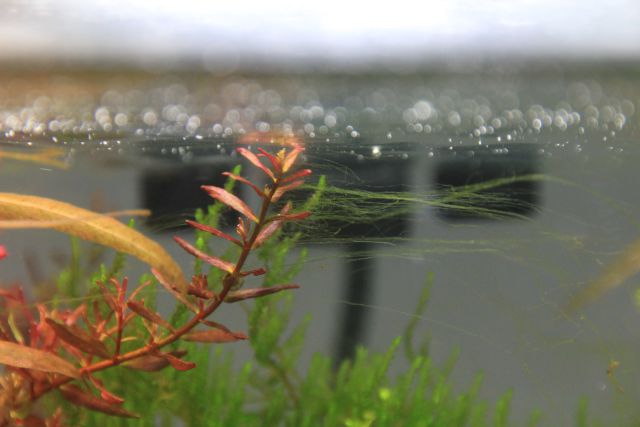
Common causes
Quite frequently this type of algae is seen in planted aquaria that are just cycling. During the first weeks, the microbiology of recently set-up tanks is still quite unbalanced. The longer the tank has been running, the more stable the ecological system becomes. In the beginning, the balance between algae and higher plants is not quite established either. Bit by bit the higher plants will get the upper hand as they grow and as the plant mass in the tank increases. It is thus very important to have an ample amount of plants in a new tank from the beginning. Especially fast-growing stem plants are really great for keeping the algae in check. The plants need to be supplied with the full range of nutrients, with liquid fertiliser and carbon (CO2). In the following list you can find the target values for the individual nutritional elements:
- A CO2 content of approximately 20-30 mg/l, measurable by a permanent test with test agent
- 10 to 25 mg/l of nitrate (NO3)
- 5 to 10 mg/l of potassium (K)
- 0.1 to 1 mg/l of phosphate (PO4)
- >10 mg/l of magnesium (Mg)
- Use only one third of the dosage recommended on the label of the iron fertiliser.
- In the beginning, the tank is lit only 6 hours per day. Increase the lighting time by 30 minutes per week. If you have medium to strong aquarium lights, we recommend 8 to 10 hours of lighting time as target. If the lights are less strong you can leave them on for 10 to 12 hours per day. Our light calculator helps you determine whether your light is weak, medium or strong.
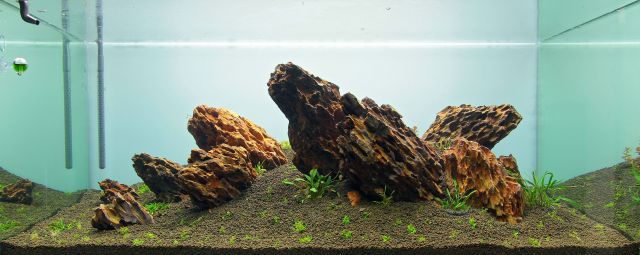
A newly set-up tank in the Iwagumi style.
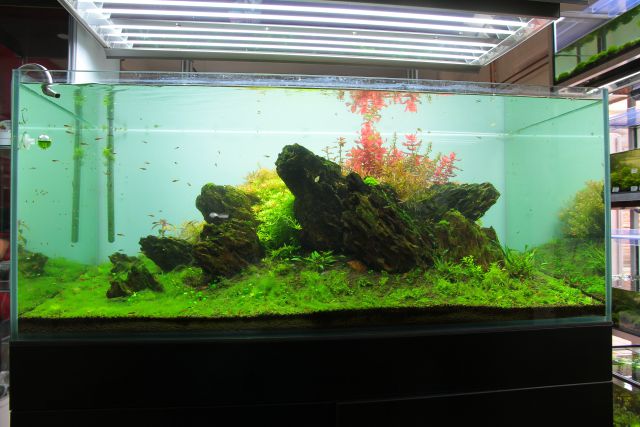
Ground-covering plants with lots of filamentous algae during the cycling phase.
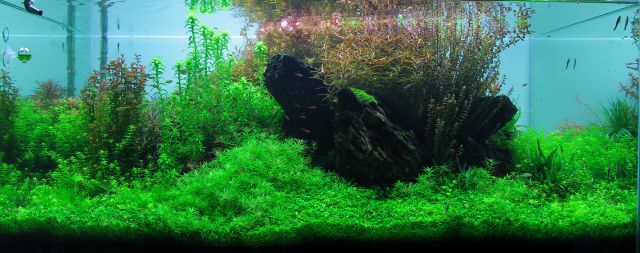
The same tank after some time has elapsed. Lush plants, no more algae.
A sudden algae outbreak in a planted tank may be due to a nutrient imbalance. Quite frequently, a nitrate or CO2 deficit are at the root of the problem, or an increased light intensity (when you have installed a new light source above your tank), daylight or overly long lighting phases.
Let us go into more detail on the most frequent causes for filamentous algae:
CO2
The CO2 content of the water should be controlled with a permanent test and test reagent. Does the indicator inside the permanent test work correctly? Replace it every four to six weeks to ensure that the test reagent shows the right color. Ideally, the content of CO2 ought to be around 20 to 30 mg/l, to which the indicator reacts with a green hue.
Light
Too much light in relation to the plant mass may be the cause of an outbreak of filamentous algae. Did you exchange your fluorescent tubes or did you switch to another lighting system? If you increase the light intensity you always need to increase the nutrient supply, too. The light intensity needs to correspond to the requirements of the plants. If you need to exchange your fluorescent tubes, do this one tube at a time.
Does the aquarium get more daylight due to relocation or because the position of the sun has shifted seasonally? This might be another cause of filamentous algae.
Under moderate to strong light, the lighting phase of the tank should not be longer than 10 hours max. For aquaria with lower light, the maximum length of the lighting phase is at around 12 hours.
Nitrate
Quite often the plants will stop growing when they do not have sufficient nitrogen at their disposal. Nitrogen can be measured in the form of nitrate. Stagnant growth of the plants often enables the algae to take over. The nitrate content (NO3) can be measured with a water test. The target values for this nutrient are at around 10 to 25 mg/l. With a liquid fertiliser like Aqua Rebell Makro Spezial N or Advanced GH Boost N, the nitrate content of the water can be increased directly without strongly elevating other nutrients like potassium or phosphate. Bring the nitrate content to a higher level by moderately giving a single dose of Advanced GH Boost N to create a nitrate reserve. To maintain the nutrients at the desired level, adjust your fertilisation regime correspondingly; use a nitrate-only fertiliser if necessary.
As nutrient imbalances may be created due to a slack of aquarium maintenance, we'd like point out that a regular water change is vital. We recommend exchanging at least 50% of the aquarium volume per week to prevent the buildup of substances in the water.
Algae control
You have problems with filamentous algae? Here we give you an array of possibilities to regain control.
At first it is important to have a sufficient number of algivores in your aquarium. Invertebrates like Amano shrimp or dwarf shrimp (like Red Bee or Red Fire shrimp) will help you keep this algae type in check.
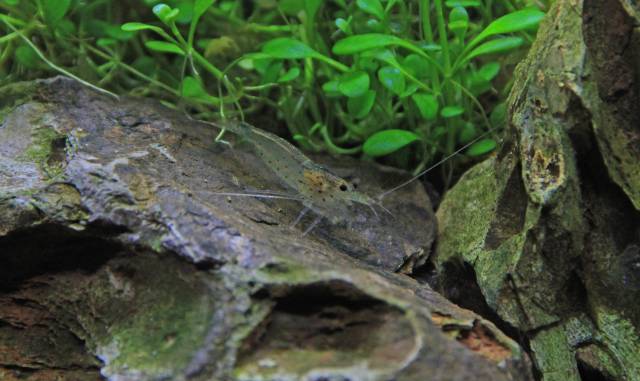
Stocking up on algivores temporarily is a good solution especially if you have several tanks. We recommend using a significantly larger number of these animals when algae appear during the cycling phase of the tank. When the tank has gained its biological balance, usually there is also a better balance between the algae and the higher plants. Then you can reduce the number of algivores and put them into another aquarium.
Does the tank have a low number of plants or are the plants slow growers? In this case we recommend you to stock up on healthy and possibly fast-growing water plants. This measure makes a lot of sense especially when your original plants are weakened by the algae infestation.
Are the algae only in a few places in your tank? You can remove filamentous algae quite easily by simply winding them onto a skewer with a rough surface. Some of the nests can even be siphoned out during a water change. If the algae keep reappearing in the same places even though you keep removing them, try fogging them with algicides like Easy Carbo or hydrogen peroxide.
Is the aquarium overgrown with filamentous algae? A black-out treatment is a rather easy and non-invasive way of reducing algae in an aquarium.
If none of these measures take effect, your last resort is a treatment of the entire tank, with an algicide like for example AlgExit or a treatment with hydrogen peroxide. Many planted tank keepers have had positive results with algicides. However, please keep in mind that using them for a longer period of time may have a negative effect on the microbiological balance, severely upsetting it. These remedies may also do damage to some aquarium plants or hinder their growth significantly. Some aquarium animals will die when exposed to AlgExit, like for example all nerites. Treating the entire tank with an algicide should therefore always be your last resort.